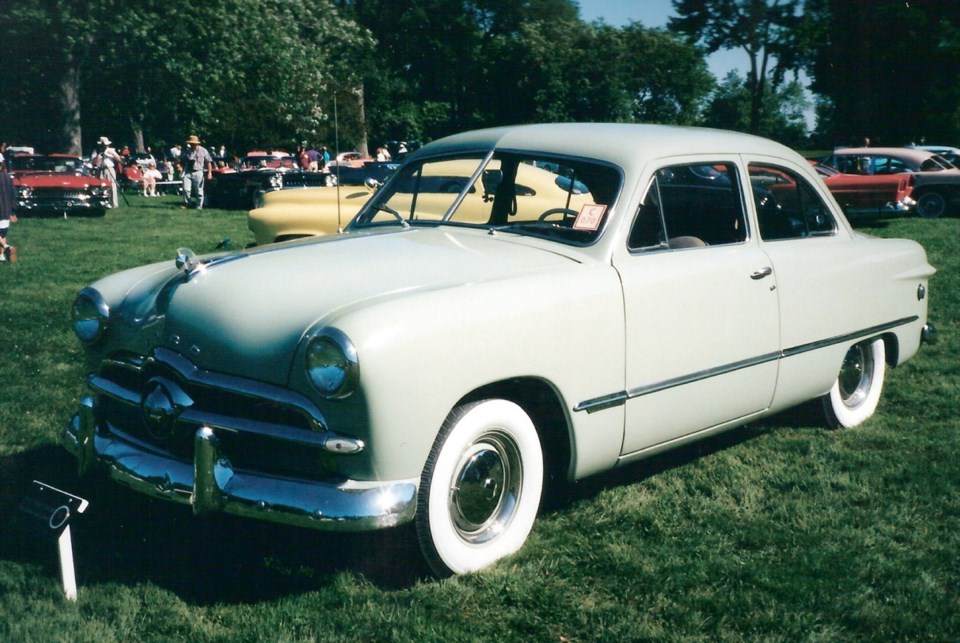After some early problems such as overheating and cracked blocks, the first low-cost Ford V-8 introduced in 1932 proved to be a wonderful engine. It was so reliable that it powered Fords for more than 20 years and continued for many more in industrial applications.
The “flathead” also became the darling of the hot-rod set, raced at Indianapolis and set records too numerous to count. From the 1930s to the ’50s, the V-8 engine became so strongly associated with Ford that when Italy’s Fiat launched its own V-8 in 1952 it called it an 8V because it believed V-8 was a Ford trademark.
But in spite of Henry Ford’s avowed opposition to six-cylinder engines, dating from the big, slow-selling 1906-’08 Ford Model K, Ford slipped a ringer into the established order in 1941 by quietly introducing a side-valve six for the American market. It displaced 3.7 litres and developed 90 horsepower, the same as the slightly smaller 3.6-litre Ford V-8.
The Six’s horsepower was raised to 95 in 1948, by which time the V-8 had moved on to 100 and 3.9 litres. The Six was introduced as a lower-priced alternative to the V-8 and wasn’t given much publicity. Ford was strongly associated with V-8s, and it was seen as the mainstream performance engine.
It was, then, somewhat of a revelation in 1950 when Mechanix Illustrated’s car tester Tom McCahill reported on a Ford Six. Tom was a staunch Ford V-8 fan, having launched his pioneering road-testing career on his own new Ford V-8. It appeared in MI in February 1946.
After a 1948 Mercury, Tom bought a new 1949 Ford V-8 and had performance tuner Andy Granatelli (later of STP and Indy car fame) of Chicago hop it up to create his famous “MI Ford.” Tom reported that for a mere $121.75 it had been modified to beat the pants off the Oldsmobile 88 and Cadillac, two of America’s fastest stock cars.
Tom was such a V-8 fan that his test of the Ford Six came as a shock to him and his readers. In his famous zero-to-60 mph acceleration run, which Tom claimed he invented, the always understated McCahill wrote: “When I got a look at my stopwatch, my eyes nearly popped out of my head: 12.1 seconds … in this little crate? Impossible! I tried it again, 12 seconds flat! I was dumbfounded.”
It was indeed too good to be true. Later checking indicated that 60 mph on the Ford’s optimistic speedometer was actually only 54.38. Correcting for this, Tom got 14.9, 14.4 and 14.5 seconds, not as spectacular but still very respectable. He noted that the best he had recorded on a Ford V-8 was 13.9, and that was a fast example; 15.0 to 15.5 was about average.
“When it comes to breaking fast from a traffic light or snap passing on the highway, the Six can make the V-8 look as loggy as your Aunt Tillie after a hard day’s shopping in Macy’s bargain basement,” wrote Tom. Regarding mid-range performance, he said: “The Ford Six can tear the ears of the V-8 in acceleration and performance, right up to 75 mph [121 km/h].” But “Above 82 or 83 mph [132 or 134 km/h], the Ford six flattens out like a Chinese pancake… it finally lays down and dies at about 91 or 92 mph [146 or 148 km/h] tops.” The Ford Six proved to be economical, too, by winning its class in the Grand Canyon economy run.
But in spite of its excellent performance and good gasoline mileage, the Ford Six never gained much popularity. Estimates put it at no more than 15 per cent of total Ford sales. In spite of this, Ford stuck with it.
In 1952 the side-valve six was replaced by a new overhead-valve six, which Road & Track reported was also quicker than the V-8. But buyers were imprinted with Ford as a V-8 car, and its overwhelming popular continued.
Overshadowed as it was, that early Ford Six carved its own tiny place in automotive history by being a sleeper that was able to out-jump its famous V-8-engined sibling, considered one of the faster American stock cars of its day.
